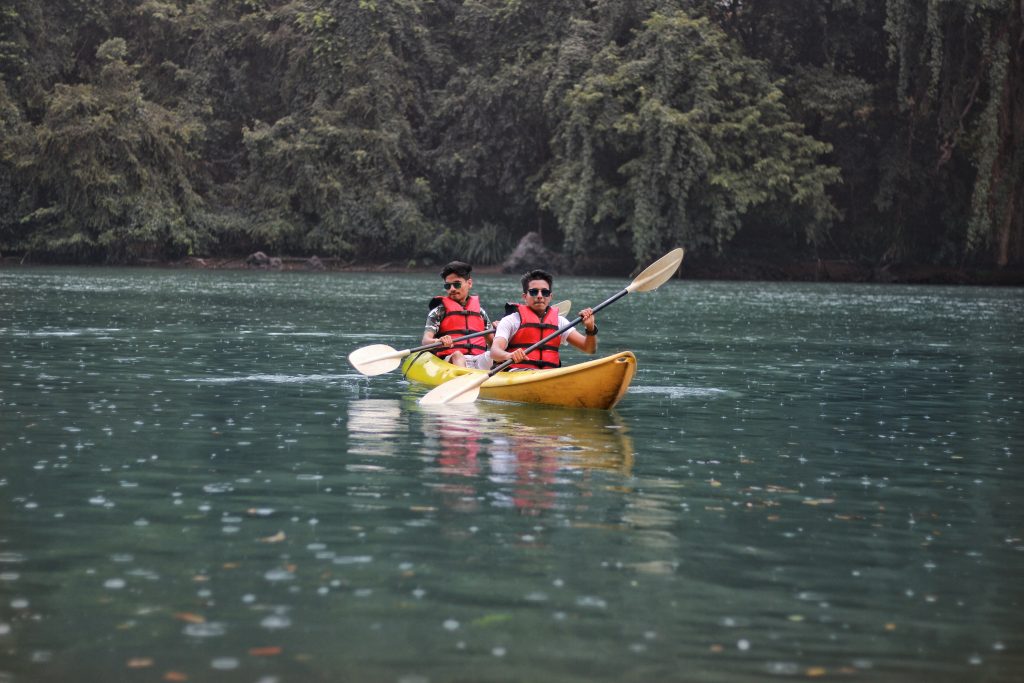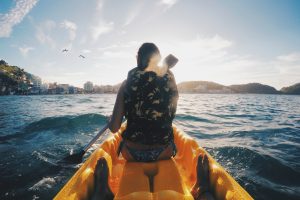-
Wear a life jacket

The most critical safety equipment you can wear while Canoeing is a life jacket. Choose a life jacket that fits properly and is approved by the US Coast Guard. It should be snug but not too tight, and your arms and shoulders should be free to move.
-
Paddle with a partner.
Paddling with a partner can enhance the experience and make it more safe. One person can steer the canoe with a stern paddle, while the other paddles with a bow paddle. This enables you to paddle in unison while remaining balanced.
-
Choose the right paddle.

The paddle you use can make or break your canoeing experience. Paddles are available in a variety of lengths, widths, and materials. The height and the width of your canoe should determine your paddle length. A shorter paddle works best in shallow water, while a longer paddle works best in deeper water. The width of the blade should be determined by your strength and the type of water you are paddling.
-
Learn proper paddling techniques.
Proper paddling techniques will help you avoid injury and paddle more efficiently. To paddle, use your core muscles rather than your arms. Maintain straight arms and use your torso to rotate your body and generate power. To avoid splashing, keep your paddle vertical and enter the water quietly.
-
Keep your weight centered.
To maintain balance and avoid tipping while canoeing, keep your weight centered. Maintain a straight posture and avoid leaning too far to one side. If you need to reach something, move slowly and carefully.
-
Watch the weather

Check the weather forecast before canoeing for hazards such as strong winds, thunderstorms, or rough waters. If the weather forecast is not favorable, it is best to reschedule your trip for another day.
-
Bring water and snacks.
Canoeing is a strenuous activity, so stay hydrated and bring snacks to keep your energy levels up. Snacks high in protein and complex carbohydrates, such as nuts, trail mix, or energy bars, are ideal.
-
Respect the environment and wildlife.
When Canoeing, be mindful of the environment and wildlife around you. Avoid leaving litter, disturbing nature, or harming plants or trees. Follow the “leave no trace” principles and leave the area better than you found.
-
Practice before heading out
If you’re new to Canoeing, practicing in calm, shallow water before venturing into more challenging waters is a good idea. Before embarking on your trip, practice proper paddling, rescuing, and steering techniques.
-
Bring a map and compass.

Always bring a map, compass, or GPS device to help you navigate and stay on course. Understand your route and any potential hazards along the way.
-
Dress for the occasion.

Dress appropriately for the weather and water conditions. Wear light, breathable clothing in hot weather and layers of warmer clothing in cold weather. Cotton clothing absorbs moisture and can make you hard.
-
Know the rules
Learn about the local boating laws and regulations. Some areas may have boating regulations like speed limits or designated no-wake zones. Always follow the rules and be considerate of other boaters.
-
Plan your route
Before you leave, plan your route and make sure you know where you’re going. Bring a map and remember hazards such as rapids, rocks, or underwater obstacles. Make plans for rest stops and ensure you have enough time to complete your journey.
-
Bring a waterproof container.

Store valuables like your phone, wallet, and keys in a waterproof container or dry bag. Ascertain that the container is securely attached to the canoe and easily accessible.
-
Don’t overload the canoe.

Overloading the canoe can cause it to become unstable and increase the risk of capsizing. Follow the manufacturer’s weight limit guidelines and distribute your weight evenly between yourself and your partner.
-
Know how to rescue

Learn basic rescue techniques, such as how to rescue someone who falls out of a canoe or how to self-rescue if you capsize. Before venturing out on more challenging waters, practice these techniques in calm, shallow water.
-
Communicate with your partner.
Effective communication is essential for a successful paddling adventure. Keep your partner updated on your plans, potential hazards, and changes in direction or speed.
-
Be aware of your surroundings.
Always be aware of your surroundings and watch for other boats, wildlife, and hazards.
-
Respect other boaters
Be courteous and respectful to other boaters on the water. Follow the rules of the waterway and yield to larger boats when necessary.
-
Have fun with it
Finally, remember to have fun and enjoy yourself. Canoeing can be a relaxing and enjoyable activity that allows you to connect with nature while spending time with friends and family.
Best Places
Below are some fantastic places you to try Canoeing:
- Lake Baikal, Russia
- HaCanoeing, Vietnam
- Milford Sound, New Zealand
- The Nile River, Egypt
- The Whitsunday Islands, Australia
- Lake Louise, Canada
- Baja California, Mexico
- The Zambezi River, Africa
- The Norwegian Fjords, Norway
- The Great Barrier Reef, Australia
Canoeing is an excellent outdoor activity that offers a unique and beautiful experience for people of all ages and skill levels. So grab your paddle, hit the water, and experience the beauty of canoeing for yourself!
Check out these before canoeing

